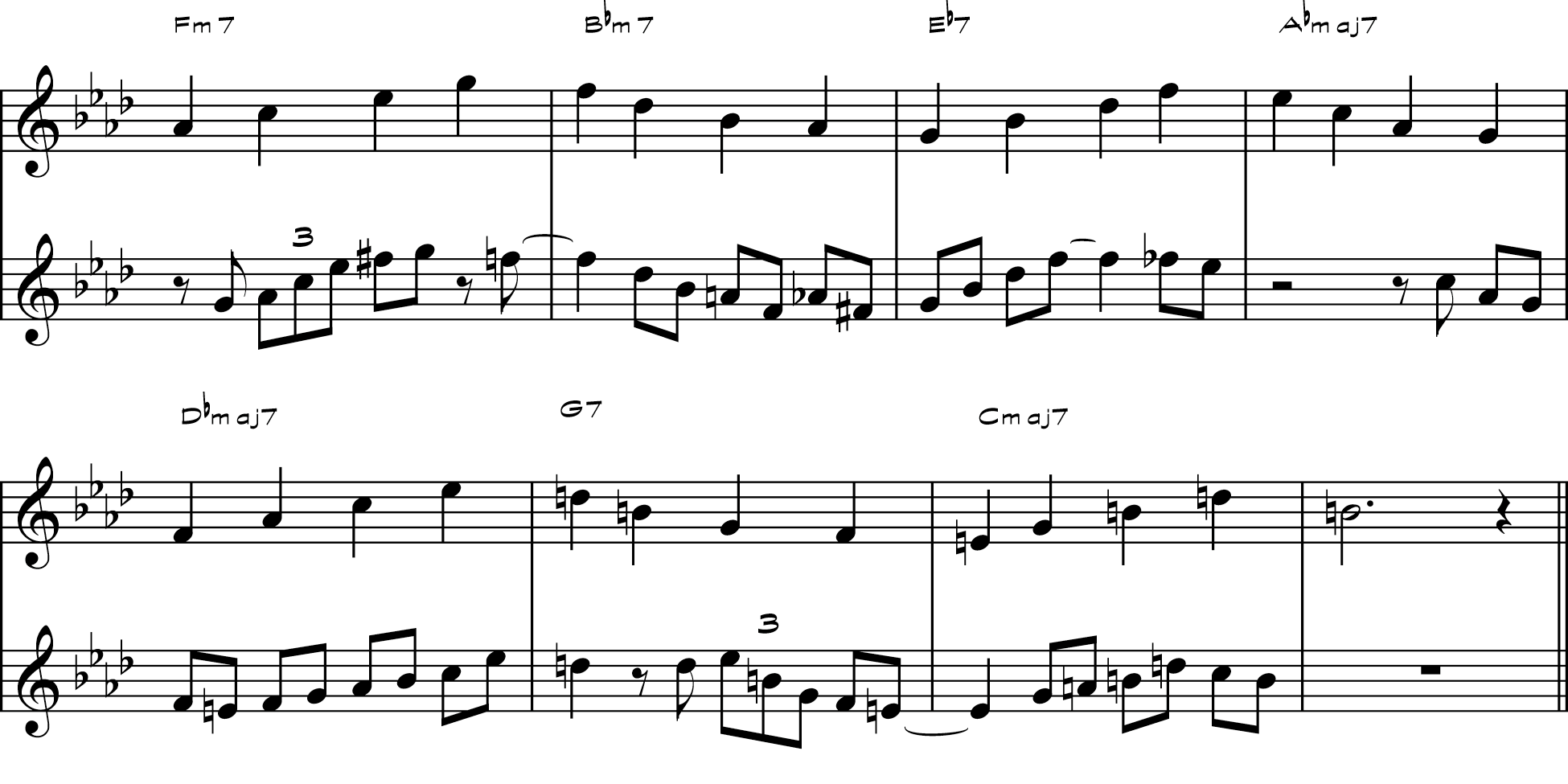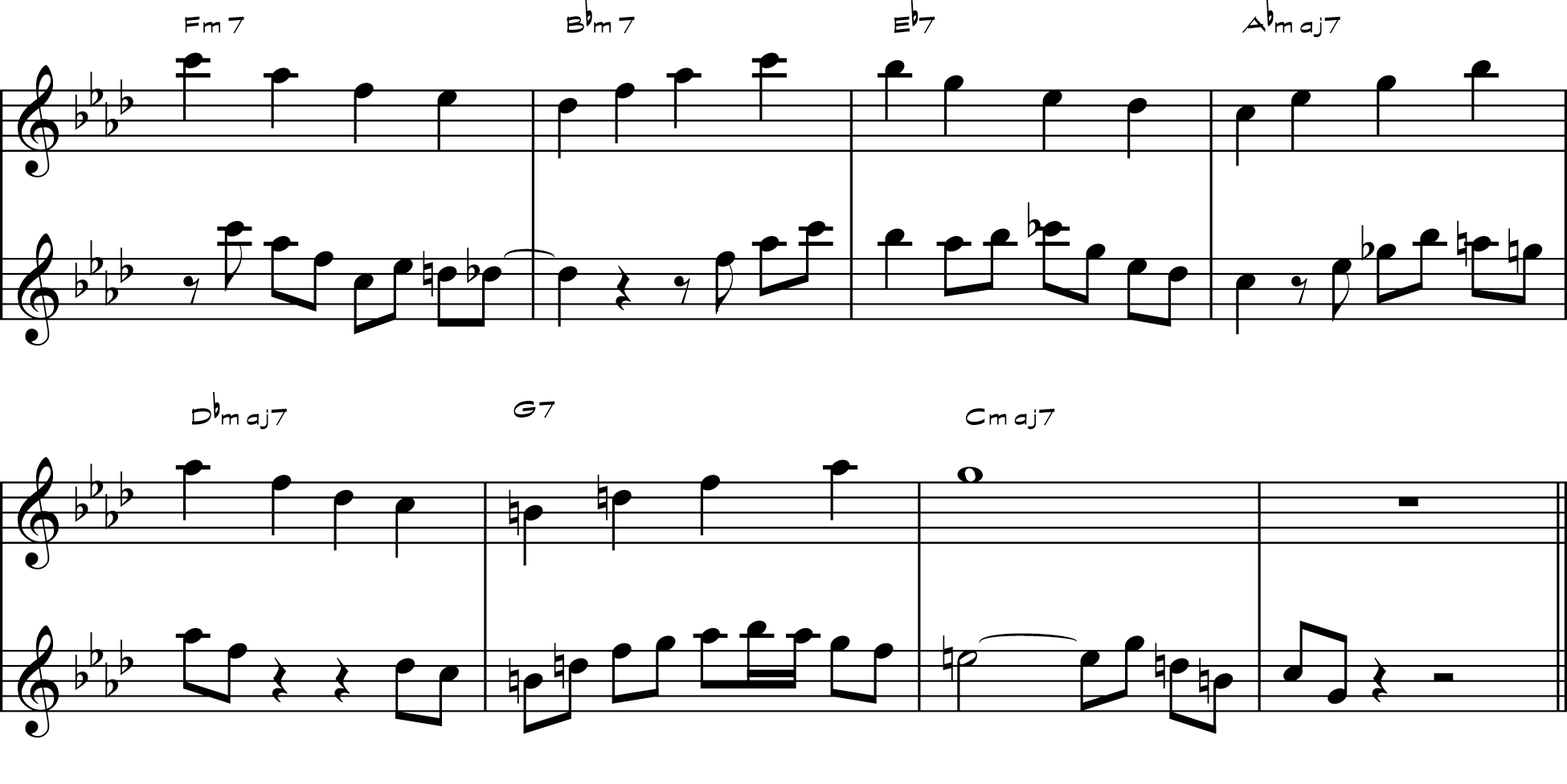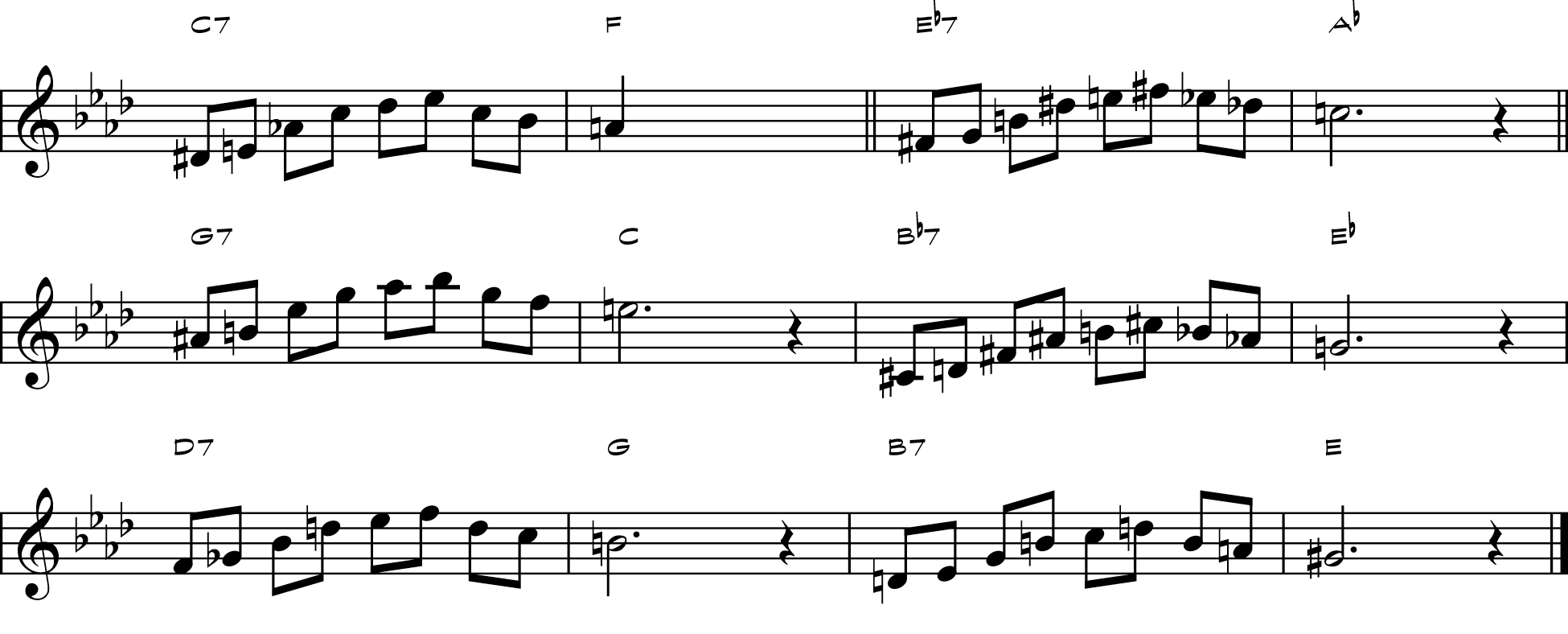Exercises Developed from Excerpts of a Keith Jarrett Improvisation on “All The Things You Are“.
Jazz educators tell students that transcribing solos will help them learn to improvise. It will certainly improve their ears if they are trying to hear the relationships of pitches in a phrase. It will do little to help their ears if they are using software to move the solo note by note and hunt and peck to find that note.
Students often ask what they should do with the solos after transcribing them. Should they learn it note for note matching articulations. I can imagine this would be very helpful. But has playing non-jazz etudes and pieces note for note with correct style helped them with improvisation? Students who focus just on memorizing other’s work, whether it is jazz solos or classical pieces are typically the least prepared to improvise, even though they may have very well developed technique on their instruments.
In order to improvise, one must get into the thinking behind the notes. That is difficult when dealing with memorizing a 128 measure solo. It might be easier when breaking apart shorter excerpts from that solo. One of my primarily classically trained students transcribed the first 36 measures of a Keith Jarrett improvisation over the chord changes to All the Things You Are from YouTube. She can probably sight read it at tempo, but is unable to improvise using the vocabulary.
I suggested taking excerpts; breaking them down, applying them several places in the progression, finding ways to connect these excerpts, and through this process, develop vocabulary. Attention should be paid to appropriate jazz phrasing, articulations, accents and good time feel.
SIMPLE EXCERPTS
Jarrett plays this simple line in the first measure of the form. It clearly lines up with the chord – a 5- 3-1 arpeggio idea with one passing tone, which could be expressed as a 5-3-2-1 pattern.

Apply this fragment to the entire progression (only the first eight measures are shown). As the pattern becomes more familiar, try different rhythmic variations.

Here is a line from m.2. It could be described as a descending arpeggio (7-5-3-1) with one pickup note or leading tone, and one passing tone.

Apply this idea to the entire progression. Some rhythmic variations and displacements can disguise the repeated pattern and make it sound more organic.

Jarrett plays this 3-5-7-9 arpeggio in m.4. In the tune itself, this chord is played as a major 7 chord.

This is a very good exercise for connecting all the chords using a 3-5-7-9 arpeggio. These arpeggios can ascend, as in mm.1-2. Eventually, you will run out of range on your instrument. A solution is to invert the arpeggios as in mm.3, 5, and 7. Repeat the exercise exchanging where you play ascending or inverted arpeggios. Several kinds of rhythmic variations can be applied, including anticipation and delayed resolutions. This exercise follows outline no. 1 (see discussion below).



Apply this arpeggio idea to the progression. Some of these excerpts may be too active to be played in every measure. It is a good idea to practice them in alternating measures. This reinforces a sense of stop and go in your phrasing. The example below plays the line in the odd measures and comes to rest on the 3rd in the even measures. (The connection of this idea resolving to the 3rd of the next chord is outline no. 2, discussed below.)

Now play the 3rd in the odd measures with the line in the even measures.

Jarrett’s line from mm.11-12 can be reduced to a simple line that connects the thirds of each chord. Jarrett also plays a 3-5-7-9 arpeggio that connects the octave leap from G to F. (This is outline no. 1, discussed below.)

Practice the line for alternating measures as shown in the previous exercises. Odd to Even:

Even to Odd:

BASIC OUTLINES
There are three common lines found in music from the Baroque period to the present. They may appear with out embellishment or may be highly figured. (I have written a book that deals exclusively with these structures: Connecting Chords with Linear Harmony, Hal Leonard, Inc.)
Outline No. 1 connects the 3rd of one chord down to the 3rd of the next.
Outline No. 2 begins with an ascending 1-3-5 arpeggio and the 7th resolves to the 3rd of the next chord.
Outline No. 3 begins with a descending 5-3-1 arpeggio and the 7th resolves to the 3rd of the next chord.
The three outlines are shown below for a G7 to C progression. The outlines are used anytime the chords progress down a fifth. Almost the entire progression for this piece is based on chords resolving down a fifth, so these basic outlines will be essential vocabulary.
OutlineNo.1 OutlineNo.2 Outline No.3

Jarrett strings two outlines together in mm.13-15. It is interesting to hear how Jarrett’s rhythmic displacement creates interest, but it is better to begin practicing them as they line up with the chords. When the lines become more familiar, experiment with displacement (both octave and rhythmic) and with various levels of embellishment.
Jarrett Line Basic Outline No. 2 & No. 1

Outline No. 2 applied to the progression using alternating measures.

Even too odd:

Jarrett Outline No. 1 Basic Outline No. 1

Jarrett outline no. 1 idea sequenced through the progression using alternating measures. Odd to Even:

Even to Odd:

Jarrett plays a 3-5-7-9 arpeggio in m.17 followed by outline no. 2 in m.18.

It may be easier to see as shown belowb. In the second setting below, a Bb replaces the An in the descending arpeggio over the D7. The B is more colorful and suggests chromatic voice-leading from the B .

The basic 3-5-7-9 arpeggios are followed by outline no. 3 in the exercise below. A very basic shape is shown on the top line. The bottom line is more embellished and rhythmically interesting and may represent how it might be in an improvised solo. It is important to be able to play the basic shapes before attempting to embellish them.

This exercise is the reverse of the previous one. This one begins with outline no. 3 followed by a 3- 5-7-9 arpeggio. The basic shapes are shown on the top line and more embellished and rhythmically active lines are shown on the bottom.

TRIADS & NEIGHBOR TONE GROUPS
Jarrett plays a simple triad shape in m.23. The basic idea is 3-5-1. Jarrett uses a neighbor tone group before playing the E.

Upper neighbor tones are usually diatonic and lower neighbor tones are chromatic. A simple 3-5-1 arpeggio is sequenced below for the progression.

Jarrett uses another 3-5-1 arpeggio in m.35, but begins with a neighbor tone group around the 3rd.

Apply this idea to the progression. As it becomes more familiar, try other rhythmic placements of the line.

The two neighbor tone groups could be combined in numerous other ways over any basic triad shape. Jarrett used a neighbor tone group around the root in m.23 and around the 3rd in m.35. The exercise below combines those groups and applies them to the progression.

ALTERED DOMINANT LINES
Jarrett plays an interesting embellishbmebnt #of outline no. 1 in mm.24-25. Jarrett’s embellishment calls.
Basic Outline No. 1Shape Jarrett’s Embellishment

This line is also useful resolving to major and may be applied to any of the V7 – I cadences in the progression.

Writers keep journals. Jazz improvisers and composers should keep notebooks of simple and embellished lines as a way of cataloging, fostering and keeping track of creative growth. All of these exercises can be transposed and used in other standard jazz progressions. Many of these exercises can be combined with one another in interesting ways. (For instance, try using one of the triad patterns with neighbor tone groupings to lead to the altered dominant line, then using another variation of the triad pattern when resolving to the I or i chord.)
All of these lines in Jarrett’s improvisation can be found in many other jazz solos, yet we can recognize his solos as uniquely Jarrett. As you internalize these common lines your own unique way of putting them together will emerge. Keep the metronome on and keep practicing!
Find Keith Jarrett sheet music transcriptions in our Library.


Browse in the Library:
Or browse in the categories menus & download the Library Catalog PDF:
